#anyways I think menswear is often more interesting than womens wear
Explore tagged Tumblr posts
Text

// had been idly looking for one of these bad boys (there's a reallly cool light blue one they make) but all the vintage stores upsell them for more than I was willing to pay for somethign I couldn't touch and feel... and then the other day, in front of this record store by my house, a guy with 3 racks of vintage sold me this for 40$
// do I need another coat? no comment
// do I need to look like a cool soft-goth dad from vermont in the 90s? obviously
#I admittedly got a great price for this#I'd say in this exact condition#and I also flicked the cuffs up like this when I wore her for the iinaugural coffee walk today#anyways I think menswear is often more interesting than womens wear#I wore a handmade in Maine lace up moc shoe with sparkly blue thin socks to really drive home the leewk
1 note
·
View note
Text
For all the discourse and sordid history of feminine clothes in period fiction or period-inspired fantasy and action stories– from endless misconceptions about corsets to the backlash where people will now complain if a female character has anything negative to say about skirts– I'm still starved for a character that crossdresses because she actually likes the way men's clothes look.
Like. In basically all the cases I've seen over the years, the reasons given for the characters' distate for feminine fashion are purely practical. "Corsets are restrictive, you can't move freely in skirts, feminine fashion is all form no function!"
And while writers often get it wrong and exaggerate how uncomfortable these clothes really were to a sometimes comical degree– you know what? Sometimes it's true! Cycling in a skirt is hard and inconvenient which is why victorian women started wearing split skirts or cycling breeches. (Which was hugely controversial to the men of the time) But like... that was, in fact, feminine fashion. Female cyclists weren't dressing like men they were just wearing a new kind of women's fashion.
Indeed, none of these characters seem to actually like masculine clothes, they give the impression that what they really want to wear is... modern women's fashion. (Which is why this kind of writing often feels anachronistic)
More than that, there is the underlying assumption that while historical women's fashion is governed by aesthetic, men's fashion is governed by use. Caring about how you look is a silly girl thing, unlike rational men who only care whether something works! Which is just... complete horse shit. Men care a lot about how they look, always have, and most masculine fashion trends cannot be explained by practicality any more than women's fashion can. It's a complete lie, based in misogynistic gender roles, that I wish wasn't repeated by media trying to be feminist. (Especially since these heroines always just happen to still be conventionally attractive– and, surprise, feminine– because everyone wants a woman who doesn't care if she's beautiful, but no one wants a woman who... actually isn't beautiful.)
If you talk to any real life butch, they love the way masculinity looks. They think they look hot! They think other butches look hot! There is a real love for masculine style there, that's just completely fucking... absent in most fiction. Because caring about your appearance a feminine trait, duh 🙄
There's an article I love in dressing dykes about Anne Lister, a real life historcial butch. And the way she incorporated masculine fashion didn't involve pants at all. It was in things like leather straps on her umbrella (customary only for gentlemen at the time) wearing men's braces, and dressing entirely in black as was fashionable for menswear but not womenswear. All of these are stylistic decisions. She did it because she liked masculinity.
If all your medieval-inspired fantasy heroine wants is practicality she'd probably start by mimicking the style of working class women. Because you know. Women worked. Women have always worked. And so they had to wear clothes suited for manual labour. There's a lot of interesting things you can do with class there, and she probably will be accused of being 'unladylike' by her environment anyway! But if she's gonna wear men's clothes, please consider letting her like them.
I'm just want an actual goddamn butch main character (or even a genuinely masc straight girl) and I'm tired of repeating the myth that men's clothes are these neutral canvasses of practical use with zero elements of style. (I have eyes! I can see that that's untrue!) Or that it's preposterous that a woman might... genuinely like these stylistic elements. That she might want to look like a man.
#fiction#historical fiction#fantasy#fashion#fashion history#gender#masculinity#femininity#gender roles#misogyny
84 notes
·
View notes
Note
is boymoding crossdressing? many such questions
it's interesting right? because in one respect i want to say, as a woman, when i wear female clothes, it is obviously not crossdressing. however, if you insist on this most of the uses of the term 'crossdressing' that have ever been said become impossible to understand. these are perhaps no more than two observations of the same phenomenon: the shallow, abstract, somewhat fictional system of gender which we learn and the deeply acquired sense of gender which often disagrees with how things should be. since i'm thinking about language all the time recently i want to make an analogy on that basis, perhaps between grammar and acquired language—after all most native speakers think they speak their own language a bit wrong and will often say, 'i say x, but you're supposed to say y...' we are capable of accomodating multiple points of view in this way.
and trans-, as in transgender, means exactly the same thing as cross-, as in crossdressing, anyway.
however isn't there something about 'going back', backpassing, using your deadname, and so forth, which feels very like a kind of crossdressing? once i settled on calling myself a trans woman i stopped doing a lot of things i used to do—wearing a lot of makeup and jewellery for example—even when i was not hiding who i was for safety reasons, because they no longer had any satisfaction for me. because i had to recloset in real life i stopped wearing my female clothes, and i had male clothes that i wore unhappily. but i then acquired a special, third set of clothes, which i would wear only in situations which were (to use what is i suppose now medical terminology) gender-affirming, such as calls with my trans friends, which were also menswear, for the reason that i was trying to do more of a masc or butch presentation. now i don't really do that, but it's something that i feel became quite common throughout the 2010s up to now, and i wonder if or how it existed previously, at least it seems common online, which is that transfems, when around other transfems, want to appear more boyish or masculine, and passing is not interesting and might even be a bit shameful. especially among girls who are my age and have been in the scene for a while. and which you might interpret as a kind of specifically in-group form of crossdressing proper to a situation where camabs wearing women's clothing is expected rather than surprising. i have known some trans men who look and behave femininely for similar reasons but i don't know enough to say it's the same phenomena. anyway it reminds me of something that Jackson Crawford, an Old Norse youtuber guy, talked about, which is that where he lives in the South in the US when he was younger you would have to take off your stetson hat when you went in a diner because that was the decorum, and if you were sitting in a diner with your hat on it was seen as extremely rude. but today if you go in a diner guys like that are all wearing their stetson hats, and he says it's because there's a change in the signficiance of the hat, and what became most important was signalling your group affiliation to the out-group rather than the in-group signalling of your knowledge of proper decorum. well maybe there is something like that, we have developed at least in some contexts a situation where in-group signalling is more important, because when you were younger the kind of expectations you were chafing against were enforced by mom and dad, while today they are enforced by WPATH.
128 notes
·
View notes
Text
I Need to be the Most Fashionable Bitch at the Airport
8/20/23
I'm at the airport heading to Grandpa's memorial. I'm wearing a black a-shirt that says "ALL THINGS ARE DELICATELY CONNECTED" (jenny holzer truism; gift), oversized black short-sleeve button up with unidentified painting of The Last Judgment (my one aliexpress purchase of weird button ups), grey sweatshirt under black motorcycle jacket (allsaints, mom utterly spoiling me), black cargo pants, sneakers, 3M aura mask.
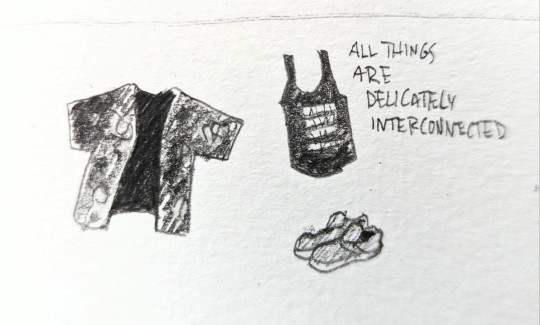

this combination is extremely comfortable and also lets me be the most fashionable person at the airport, an extremely low bar. as a transmasc its my god-given right to wear oversized shirts. it helps the fit issue of having more hip than mens shirts account for, and can widen the shoulder. i feel most comfortable in clothes that drape my back and hips, that dont come in at the waist, so i often wear these button ups open. its one of two silhouettes that dont make me insanely dysmorphic.
oversized transmasc fashion is sometimes ridiculed but personally im a fan, even as someone who believes right fit is important. 'right ' is just relative. trans/queer people are often manipulating our proportions to pass or signal, and thats because fit and silhouette in fashion is gendered.
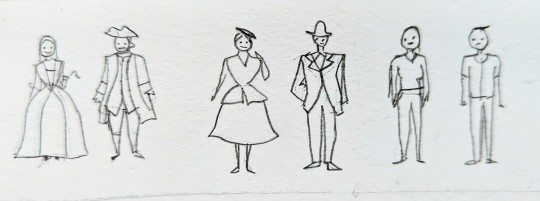
off the bat, wearing oversized or proportion-fucking clothing is a lot easier when youre straight sized because there's more clothes for you period and you can find things a size up. also fatness is gendered in a complex way so Your Millage May Vary. anyway—
right now men's and women's silhouettes are very similar. its all slim and about moralizing and accentuating the ''"natural body"". and by accentuate I mean make women look skinnier with a fatter ass and men look skinnier with more muscles. it sucks ass. I could go off on a long rant about the politics of athleisure. there are more variations in shape in streetwear etc. but mens office and formal wear is all very slim right now (derogatory).
this is very different from 1600s france or 1950s america, where the male and female form in fashion were quite different. please dont make the mistake of thinking this uniformity/unisexing is a linear, progressive trend. there are rather cycles of feminizing menswear and masculinizing womenswear based on previous generations (1890s, 1920s, 1960s-now kind of).
so right now, if we want to 'pass' or genderfuck or navigate being gendered correctly, we rely on fine-haired signals. (it's easier to queer code and be read as 'some flavor of gay' ime.) and a lot of that is based on the shape of our bodies. wearing a men's jacket isn't going to shift my gender signals much since women wear menswear inspired womenswear and, to a lesser extent, menswear—but wearing a mens jacket a size up so my shoulders seem wider will shift the needle more. and even if it doesn't, I like how it looks.
there's not actually a formula for this because passing and gendering are highly specified to location, culture, race, age, fatness, how aware of trans people someone is, if there are other queers around you, etc.
more interesting than dialogue about passing are the weirdo trans/queer fashions happening right now which, like all interesting fashion these days, actually have bold shapes. transmasc, butch, and stud fashion often make use of oversized and baggy clothes, especially with the 90s / cargo / wide pant resurgence. and there's lots going on with weirdo niche fashion like clowncore. people were dragging Elliot Page's fashion (Balenciaga 2022, 2021 met gala) but its deliberate.
I feel pretty gay and trans at the airport, especially when I hit the middle of the country. but I did once see a man flagging black at an airport with a tattoo that said "ITS A LIFESTYLE"—so there's room for improvement.
2 notes
·
View notes
Text
Tim Tronckoe’s History With Ghost + Analyzation of the Preview Imagery
No one asked for this but here it is anyway in case someone cares.
Tim Tronckoe (Instagram, Website, Facebook) first hooked up Ghost during Papa II’s reign and took some iconic shots way back when.


He did the same for Papa III: some live photos that have been saved and re-uploaded to Pinterest, Tumblr, etc. that I forgot how clear this particular original one was (unfortunately the high res versions are no longer on his site).

He also took what I believe was one of the last, if not the last fancy promo photo of Papa III and the ghouls.

(I can’t tell which of those beefy boys is Chris and which is Ben)
Unbeknownst to I think most Ghost fans, Tim started dropping hints at some sort of 18th century French rococo-style project as far back as May 19, 2019.
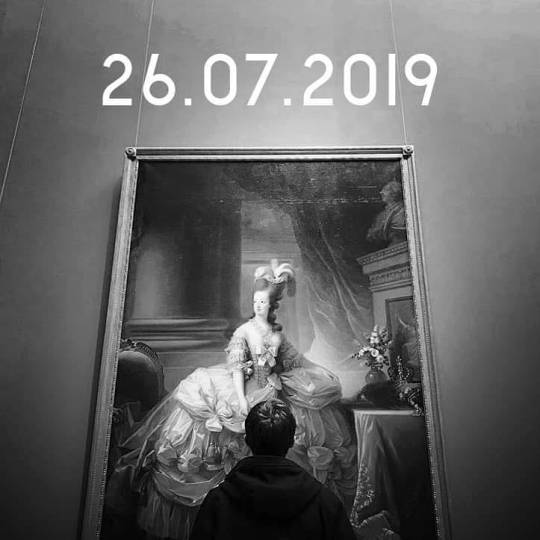
A person looking up at Élisabeth Louise Vigée-LeBrun’s portrait of Marie Antoinette. This is currently held at the Kunsthistorisches Museum in Vienna.
Two weeks later on July 3, Tim posted a second 26.07.019 image to his Instagram:

More French rococo, sort of: this is a very casually made 18th century menswear costume. The style is based on something like this which you’ve probably seen in a ton of movies set in the late 1700s. Nothing to indicate anything Ghost-y...

... until the next day. Sort of. Skull rings aren’t exactly Ghost-specific but it’s an interesting combination of styles. So that was July 4.
On July 6, a short compilation video of an old cathedral as well as numerous women in historical fashions, including
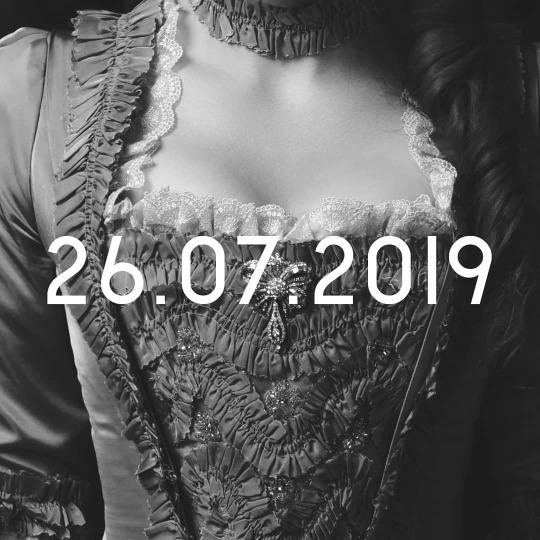
A woman in the makings of a “robe à la française” style dress from the 1760s-1780s. Probably easily identifiable as “Marie Antoinette” dress and thus associated with the excess, irresponsibility, and heartlessness associated with the French aristocracy of the time. The brooch shows up in some of the preview videos. This style of scrunchy ruffles is iconic and shows up in a fuckton of costumes but at this point I don’t think anyone is still reading/cares.
The next video shows the wearer of said dress in the signature (I’m saying this a lot) powder blue Marie Antoinette was and still is often depicted in, perhaps most famously in this portrait on display at the Palace of Versailles.
So this definitely isn’t just your everyday 1700s stuff, it seems to point specifically to either Marie Antoinette or a symbol of the aristocracy.
But there’s also a significantly less formal, much plainer all-white dress from the same era as indicated by the shape of the stomacher and the pannier.
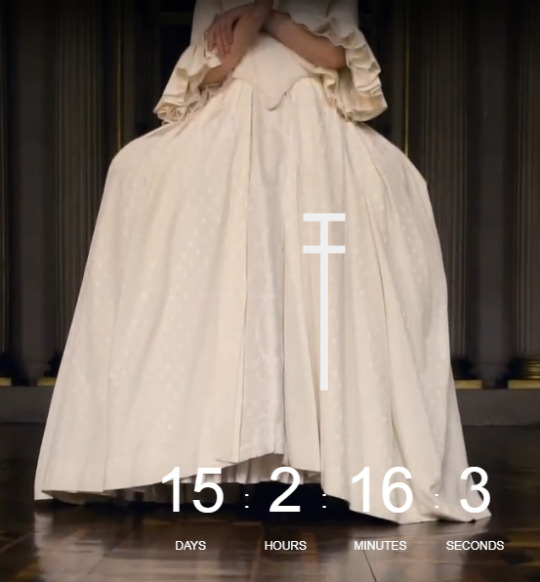
But they didn’t stop at the 1700s?! Someone is wearing a Tudor ruff from the 1500s? They’re probably most associated with Queen Elizabeth I (below) and Shakespeare.
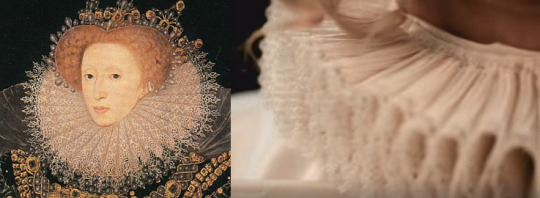
Also Anne Boelyn is there????

There’s also someone in white (Elizabethan person?) with white crucifix accents on fabric somewhere and an ornate prayer book.
But most important:
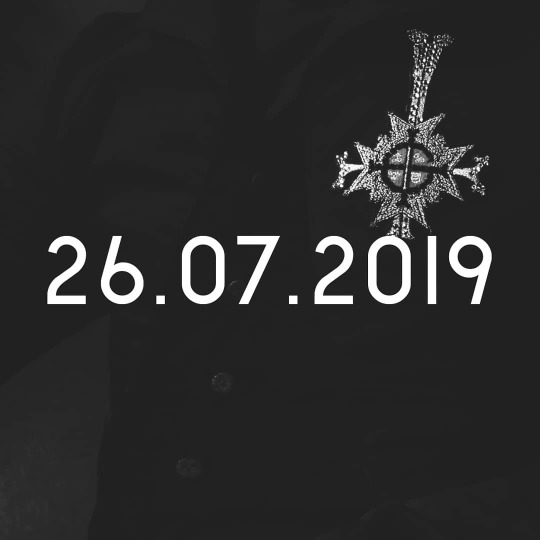
Cardinal fucking Copia. That is absolutely his black suit.
Given Ghost has been all over Europe lately and I’m pretty sure this was filmed in Europe, I’m really hoping Copia and, in particular, TF will be physically present in these scenes rather than filmed separately à la the He Is video. It seems like the perfect opportunity given the whole cardinal thing.
But who knows. See you in 15 days.
Thank you for coming to my stupid TED talk.
233 notes
·
View notes
Text
Issue #11: Sarah Effenberger
en | de
The world of fashion is no longer split along the line of gender. The line, of course, still exists, but many young designers see it rather as an invitation for exploration than as an imposition. Sarah Effenberger is one of those young fashion designers who want to question or even challenge the power of the line without having to follow an overly cerebral and often quite entrenched gender discourse. As the art director of her own fashion label FOMME, she has developed an aesthetically unique approach to the unisex concept. Her creations captivate with well composed contrasts – they are subtly elegant and playfully provocative, nostalgic and highly topical, intellectually stimulating and sensually engaging, crazy and serious at the same time. I visited Sarah Effenberger in her Berlin atelier to talk about her personal take on fashion, the source of her inspiration and the end of the infinite jest.

Peter Koval: How did you start designing menswear for women?
Sarah Effenberger: Sometimes I like to wear apparel that’s labeled as “men’s fashion”. However, I often experience that the size just doesn’t work for me. Maybe that’s why I also did research on unisex-labels during my university studies. Unisex-labels usually only offer one size for all, which often means that not everybody can wear it. Women simply have a different body shape than men. I wanted to create a unisex concept which wouldn’t deny the different body shapes, but rather makes it a design principle, while at the same time eluding clear gender assignment.
PK: And that’s how homme became fomme…
SE: Yes. But the play with the silhouette and specific cut also has a historical background. If we look at the times before industrialization of textile production, we see that it’s the man who was often the “colorful bird”. Today, if men want to dress more eccentric and more sensual, they are automatically running into danger of not being taken seriously. With my collections, I want to counter this attitude. I want to entice them to more fun and freedom in fashion – without the need to give up the elegance or masculine erotic charisma.
PK: That sounds as if you want to emancipate men with your fashion.
SE: (laughing) It sounds strange, doesn’t it? But why not? I believe that women in our society still have to fight for equal opportunities. However, at least here in Europe, we are on a good way. When it comes to fashion, I’m really happy to be a woman. It’s harder for men in fashion these days.
PK: Why do we know so little about fashion?
SE: I think that sometimes we aren’t aware of how much we even know about fashion. For me, fashion is a mirror of society.
PK: Are there actually still taboos in fashion?
SE: Probably not. Some time ago, even a kind of “nazi-fashion” was en vogue. And this wasn’t for punks or another subculture but for the mainstream. It was a rebellion, of course, but rather an aesthetic one, without being explicitly politically charged. It was ok when ordinary people wore Lonsdale sweater and would shaving their heads. Raf Simons pushed that a lot with his models.
PK: Is there anything you would never wear?
SE: I understand my body. That’s why I don’t wear certain clothes. But it’s not a matter of principle.
PK: How important is the “blind seeing”, the touch for you?
SE: For me it’s important that you can feel the theme I’m working on with all of your senses. This is, of course, not always possible to do or realize because I’m dependent on the supply of the fabric manufacturers. I was really happy when I found the fabrics for my last summer collection. The motto was “Klaus Nomi goes to the beach” (laughing) and I was desperately looking for striped patterns when I found this fabric with a towel-like feel to it. Wonderful!
PK: I noticed that the use of natural fabrics leads to more conservative cuts and vice versa, the more eccentric the forms the more often you can see polyester. Can you explain it? Or is that not the case?
SE: I would say that’s right. There are probably still many people who believe that they need technical fabrics to design modern apparel. In the 1960s and 1970s, this was the future. But that’s already fifty years ago… Polyester is a really difficult topic. For example, if you want to achieve good prints or if you want to avoid creases, then it can be really convincing, particularly if it’s just a percentage of the fabric. However I prefer to use natural fabrics as much as possible.
PK: Do you sketch a lot before you sew? Or do you begin directly with the fabric? How do you work?
SE: To be honest, I don’t sketch that much. Usually I write down my ideas. In letters! Many of my designs are created in my mind. Since, as a self-employed fashion designer, I don’t have to communicate my ideas through pictures, my handwritten notes are mostly sufficient. Maybe I am also too impatient and want to see the result immediately. Of course I draw when it’s needed. It is also important, but it’s just a small part of the creative process. The actual design phase is quite short anyway. At the university we had much more time for that. As an independent fashion designer, I spend more time with marketing, administration, PR, as well as sampling and cutting, than with the actual design. But that’s ok. If you understand who you are and you’ve found your own style and you also know who your customers are, then the biggest part of the creative groundwork is done.

A look in the atelier of FOMME.
PK: Trends as unification of colors, forms or materials and uniqueness as expression of creativity, individuality or even of an anti-attitude… Originality and imitation: How does it fit together?
SE: It doesn’t fit together at all. You have to learn to deal with it. You are always following some trends and discovering things others discovered a long time before. Maybe it’s too late for a radical newness. However, it’s possible in fashion to claim some originality even if it’s within certain trends.
PK: Pictures of fashion want to be seen at any cost. They are addicted to attention. And it’s also hard to overlook them. How do you deal with that as a fashion designer? Don’t you want to look away sometimes?
SE: I really like to see what others are doing! But for me it’s also a question of quantity. Usually I don’t have the time to grapple with the daily torrent of images. Sometimes I even have to force myself to do so, just to keep up with my professional interest. To be honest, when I have some free time, I prefer meeting friends over checking instagram.
PK: Did you always want to make fashion?
SE: No. It wasn’t a straight path here.
PK: So you made an apprenticeship as a banker first…
SE: (laughing) I was searching for a long time. I came to Berlin in my early twenties and I wanted, as many people back in the day, to do something with design, something creative. More or less coincidentally, I ended up in the entrance examination for fashion design at the HTW (Hochschule für Technik und Wirtschaft) and I was accepted. During the first year I even opened a little shop together with friends. But I never thought this would be my profession one day. After one year I changed to visual communication, but I quickly realized that I’m not a full-blooded graphic designer. After an orientation phase, I decided to study fashion design again, but this time at the UdK (Universität der Künste). Quite late indeed. Sometimes I think that it would be nice if I would have known what I wanted to do earlier. But now, when I look back, I think that this was probably the right way. At the end, the detour through graphic design proved to be quite helpful in the everyday life of a fashion designer.
PK: Is there a time period you are fascinated by?
SE: I like to work with nostalgia. I often get inspiration from periods during the 1920s and 1970s. But it depends on the theme. For example I like pants from the 1920s, but I’m not interested in many other things from that decade. For me personally, the 1990s were very important, not only because I grew up in that period. The second half of the 20th century was marked by the amazing acceleration towards the future – and in the 1990s, it became even more dense. Around the year 2000 it somehow stopped, the thrill was gone, the “infinite jest” was over. As if we want to go back since then. As if we wouldn’t dare to enjoy properly, to have fun, to be loud and colorful, or just to say what we actually want without thinking about the consequences first. The bad conscience seems to rule us and forces us to do many things very consciously. It inhibits us. I see this as a great pity. However, I feel good in the present and I also look optimistically towards the future.
Credits
Interview and photo: Peter Koval
English editor: Julie Anne Miranda-Brobeck
Did you know that you can support Lineatura Magazine by buying the very original Lineatura notebooks? Get the same notebooks that all our interviewees use for their creative ideas and read more inspiring interviews in the future!
INTERVIEW MIT SARAH EFFENBERGER
Die Welt der Mode ist nicht mehr durch die Linie des Geschlechts zweigeteilt. Diese Linie existiert zwar nach wie vor, aber für viele junge Designer ist sie eher ein Anlass zum Experiment als eine Vorgabe. Sarah Effenberger gehört zu denjenigen Modedesignern, die diese Linie hinterfragen oder gar herausfordern wollen, ohne dabei unbedingt einem verkopften Gender-Diskurs folgen zu müssen. Mit ihrem eigenen Label FOMME schuf sie eine ästhetisch einzigartie Neuinterpretation des Unisex Konzepts. Ihre Kreationen zeichnen wohlkomponierte Kontraste aus; sie sind zugleich subtil elegant und spielerisch provokativ, nostalgisch und hochaktuell, sinnlich ansprechend und intellektuell stimulierend, seriös und verrückt. Ich besuchte Sarah Effenberger in ihrem Berliner Atelier, um über ihren persönlichen Zugang zur Mode, die Quelle ihrer Inspiration, aber auch über das Ende von unendlichem Spaß zu reden.

Peter Koval: Wie kamst du denn dazu Herrenmode für Frauen zu entwerfen?
Sarah Effenberger: Ich persönlich bediene mich gern auch in der Herrenmode, muss aber oft feststellen, dass es an der Größe scheitert. Vermutlich deswegen habe ich mich während meines Studiums auch intensiv mit dem Unisex-Ansatz beschäftigt. Unisex-Label bieten in der Regel eine Größe für alle an, was aber häufig dazu führt, dass es eben nicht alle tragen können. Frauen haben nun mal eine andere Figur als Männer. Ich wollte ein Unisex-Konzept kreieren, welches die unterschiedlichen Körperformen nicht negiert, sondern umgekehrt, sie zum gestalterischen Prinzip erhebt und sich zugleich einer eindeutigen geschlechtlichen Zuordnung entzieht.
PK: Und so kam homme zu fomme…
SE: Ja. Das Spiel mit den Silhouetten und der Schnittführung hat aber auch einen historischen Hintergrund. Wenn man in die Zeiten vor der Industrialisierung der Textilherstellung schaut, dann sieht man, dass der Mann oft der bunte Vogel war. Wenn sich Männer heute etwas ausgefallener oder sinnlicher kleiden, dann laufen sie automatisch Gefahr, nicht mehr Ernst genommen zu werden. Mit meinen Kollektionen will ich dagegen halten und sie zu mehr Spaß und Freiheit in der Mode verleiten; und das ohne Verzicht auf Eleganz oder männlich-erotische Ausstrahlung.
PK: Das klingt beinahe so, wie wenn du mit deiner Mode Männer emanzipieren möchtest.
SE: (Lacht.) Zugegeben, es hört schon etwas komisch an. Aber warum nicht? Ich finde, dass die Frauen in unserer Gesellschaft nach wie vor für ihre Gleichstellung kämpfen müssen. Aber zumindest hier in Europa, sind wir schon mal auf einem guten Weg. Was die Mode betrifft, bin ich froh, eine Frau zu sein. Die Männer haben es heute in der Mode schwerer.
PK: Warum wissen wir so wenig über die Mode?
SE: Ich glaube, manchmal ist es uns gar nicht bewußt, wie viel wir eigentlich alle über die Mode wissen. Für mich ist Mode ein Spiegel der Gesellschaft.
PK: Gibt es noch Tabus in der Mode?
SE: Vermutlich nicht. Vor einiger Zeit war sogar eine Art “Nazi-Mode” en vouge. Und das nicht bei den Punks oder bei einer anderen Subkultur, sondern als Mainstream. Es war schon eine Rebellion, allerdings vielmehr eine ästhetische, ohne eine explizite politische Aufladung. Es war in Ordnung, wenn normale Menschen Lonsdale Pullis trugen und sich die Köpfe rasierten. Raf Simons hat das mit seinen Models ziemlich vorangetrieben.
PK: Gibt es etwas, was du selber nie tragen würdest?
SE: Ich habe meinen Körper verstanden. Allein deswegen zeihe ich einige Sachen nicht an. Es ist aber nichts Prinzipielles.
PK: Wie wichtig ist das das blinde Sehen, das Fühlen für dich?
SE: Ich finde es sehr wichtig, dass sich das Thema, an dem ich arbeite, auch in der Haptik niederschlägt, dass man es mit allen Sinnen begreifen kann. Das geht natürlich nicht immer, denn meistens bin ich auf das Angebot der Stoffhersteller angewiesen. Ich war wirklich sehr froh, als ich die Stoffe für meine letzte Sommerkollektion – sie stand unter dem Motto “Klaus Nomi geht an den Strand” (lacht) – gefunden habe. Ich habe länger nach Streifenmustern gesucht und dann fand ich diese Stoffe, die sich ein bißchen wie Handtücher anfühlen. Herrlich!
PK: Mir ist aufgefallen, dass die Verwendung von natürlichen Stoffen in der Mode eher zu konservativeren Schnitten führt und umgekehrt, je ausgefallener die Formen, desto häufiger sieht man Polyester. Kann man es irgendwie erklären? Oder stimmt es gar nicht?
SE: Irgendwie stimmt es. Vermutlich glauben immer noch viele, dass sie technische Stoffe brauchen, um moderne Kleider zu entwerfen. In den 1960er und 1970er Jahren war das die Zukunft. Das ist aber auch schon fünfzig Jahre her… Polyester ist wirklich ein schwieriges Thema. Wenn man zum Beispiel gute Drucke erzielen möchte oder Knitter vermeiden will, dann kann er durchaus überzeugen; zumal wenn er nur anteilig in einem Stoff vorhanden ist. Ich bevorzuge aber möglichst natürliche Stoffe.
PK: Skizzierst du viel bevor du nähst? Oder fängst du gern gleich mit dem Stoff an? Wie arbeitest du?
SE: Ehrlich gesagt, skizziere ich nicht so viel. Ich schreibe meine Ideen häufig auf. Und zwar in Buchstaben! Viele meiner Entwürfe entstehen im Kopf und da ich als selbstständige Modedesignerin nicht darauf angewiesen bin, meine Ideen als Bilder zu kommunizieren, reichen häufig Notizen aus. Vielleicht bin ich auch zu ungeduldig und will immer gleich das Ergebnis sehen. Natürlich zeichne ich gern, wenn es darauf ankommt. Es ist auch wichtig, aber es nimmt relativ wenig Zeit ein. Die eigentliche Entwurfsphase ist ohnehin relativ kurz. Im Studium hatten wir noch extrem viel Zeit dafür. Als selbstständige Modedesignerin verbringe ich mehr Zeit mit Verwaltung, Marketing, PR, aber auch mit Schnitt oder Sampling als mit dem eigentlichen Entwurf. Aber das ist auch ok so. Wenn du verstanden hast, wer du bist, wenn du deinen Stil gefunden hast und wenn du weißt, wer deine Kunden sind, dann hast du eigentlich den größten Teil der kreativen Vorarbeit geleistet.

Ein Blick ins Atelier von FOMME.
PK: Trends als eine Vereinheitlichung von Farben, Formen, Materialien und Einzigartigkeit als Ausdruck der Kreativität, Individualität, oder gar Unangepasstheit… Originalität und Nachahmung: Wie geht es zusammen?
SE: Gar nicht. Man muss lernen, damit umzugehen. Man folgt unweigerlich irgendwelchen Trends oder entdeckt ständig Sachen, die andere bereits früher endteckt haben. Für radikal Neues ist es vermutlich zu spät. Dennoch ist es in der Mode durchaus möglich, wenn auch innerhalb bestimmter Trends, gewisse Originalität für sich zu beanspruchen.
PK: Die Bilder der Mode wollen um jeden Preis gesehen werden. Sie sind süchtig nach Aufmerksamkeit. Und sie sind auch kaum zu übersehen. Wie gehst du als Modedesignerin damit um? Willst du nicht manchmal einfach wegschauen?
SE: Ich schaue mir schon gern an, was andere so machen! Allerdings ist es für mich auch eine Frage der Quantität. Ich habe meistens keine Zeit, mich täglich mit der Bilderflut auseinanderzusetzen. Das geht dann manchmal so weit, dass ich mich dazu schon aus rein professionellem Interesse zwingen muss. Und ganz ehrlich, wenn ich etwas Zeit habe, dann will ich lieber Freunde treffen als Instagram checken.
PK: Wolltest du schon immer Mode machen?
SE: Nein. Es war kein geradliniger Weg.
PK: Also hast du zuerst eine Bankkauffraulehre gemacht…
SE: (Lacht.) Ich habe lange gesucht. Ich bin mit Anfang zwanzig nach Berlin gekommen und wollte, wie so viele damals, irgendetwas mit Design machen, etwas Kreatives. Mehr oder weniger zufällig landete ich in der Aufnahmeprüfung für Modedesign an der HTW und wurde aufgenommen. Bereits während des ersten Studienjahrs machte ich mit Freunden nebenbei einen kleinen Laden auf. Ich dachte aber nie, dass es mein Beruf wird. Nach ungefähr einem Jahr wechselte ich zur visuellen Kommunikation, habe aber relativ schnell gemerkt, dass ich keine Grafikerin bin. Nach einer Findungsphase habe ich mich dann entschlossen, doch noch einmal Modedesign zu studieren, diesmal an der UdK. Ziemlich spät also. Manchmal denke ich, dass es schön gewesen wäre, wenn ich vorher gewusst hätte, was ich machen will. Aber wenn ich jetzt darauf zurückblicke, dann war das vielleicht sogar der richtige Pfad. Denn der Umweg über die Grafik erweist sich im Modealltag immer wieder als äußerst hilfreich.
PK: Gibt es eine Zeit, die dich ganz besonders fasziniert?
SE: Ich arbeite gern mit Nostalgie. Ich schöpfe häufig Inspiration aus den 1920er bis 1970er Jahren, es kommt aber auf das einzelne Thema an. Zum Beispiel mag ich Hosen aus den 1920er Jahren, aber vieles andere aus dem Jahrzehnt interessiert mich widerum gar nicht. Für mich persönlich sind die 1990er ganz wichtig gewesen; nicht nur weil ich in der Zeit aufgewachsen bin. Die zweite Hälfte des zwanzigsten Jahrhunderts war stark von einer aufstrebenden Beschleunigung Richtung Zukunft geprägt und in den 90ern – das Millenium vor den Augen – hat es sich noch einmal verdichtet. Um das Jahr 2000 hat es dann irgendwie aufgehört, die Luft war raus, der “unendliche Spaß” vorbei. Als ob wir seitdem wieder zurück wollten. Als ob wir uns nicht mehr trauen würden, richtig zu genießen, Spaß zu haben, laut und bunt zu sein, oder auch nur zu sagen, was wir eigentlich wollen, ohne zuerst an die Konsequenzen zu denken. Das schlechte Gewissen regiert und zwingt uns, viele Sachen ganz bewusst zu machen. Es hemmt uns. Und das finde ich schon schade. Aber ich fühle mich wohl in der Gegenwart und schaue auch zuversichtlich in die Zukunft.
Interview & Foto: Peter Koval
Wußten Sie schon, dass Sie das Lineatura Magazin mit dem Kauf unserer originellen Notizbücher unterstützen können? Holen Sie sich dieselben Notizbücher, die die Interviewten verwenden, um ihre kreativen Ideen festzuhalten und lesen Sie künftig mehr inspirierende Interviews!
0 notes
Link
Adam on a recent train trip
Introduction
I never really truly appreciated mens style until I met Adam. I'd admired mens fashion from afar, appreciated the many men at Fashion Week and London Men's Collections and eagerly watched the updates on the WGSN style pages, I liked looking at how people put their clothes together and how they wore what they wore, It was never about the labels or designer clothes they were wearing. It was all about the personality wearing the clothes. Then I met Adam, a dapper man in his early 20's (Back then anyway!) living in the city with a professional job. Polished, dressed for any occasion, all the time. The first time we met I remember thinking 'He dresses better than I do' and since that moment he sets the sartorial bar.
All in the detail: watch and scarf
As our relationship has developed, I've learnt more and more about how men choose their clothes, It's no longer women who tailor pick their clothes to express themselves. It's an important and overlooked area of a modern mans life and is in no way vain, self absorbed or self important, It's so refreshing to meet a man who cares about his appearance.
Waiting for the train
Adam is a shirt kind-a guy, no matter the occasion, he'll opt for a shirt over a t-shirt, unless we're just running errands, it's what he's comfortable in and he finds that he is able to be more relaxed and himself if he feels comfortable and confident in his clothes. It's great to watch him put clothes together, then select accessories that create the whole look. He's very quick at it too.
Side by side, sartorial similarities
People often say that couples have a common visual stylistic thread. I see similarities, but I'm still very much on my style journey to discover my 'Look' Adam is so fortunate to have already found his, I envy him. But on the positive side, It makes him easy to buy gifts for.
Quality over quantity, classic styling over trends
Recently, for Christmas Adam's grandmother bought him the most beautiful men's scarf. Thin, blue striped a real winter gem. A gift that slides right into his wardrobe, it's functional and a need rather than a want. A classic, timeless quality piece that will last more than a few colder seasons.
Dezeen watch, glasses standard prescription supersavers rims
Adam always opts for quality over quantity, enjoying both mid market brands, independent brands and the occasional basic high street piece. Vintage jumpers and retro band t-shirts also feature in his weekend and super casual arsenal, a contrast to his 9-5 Monday to Friday look, but once again reflects his hobbies and interests.
A hot drink for the journey
Fortunately, working in Architecture allows the creative flair to flow through the wardrobe. Whilst staying professional, Adam doesn't ever loose his personality. I see that through the coloured laces in his shoes, his watch collection, his very jazzy socks peaking from under his turned up and rolled trousers and his latest love, a vintage full size umbrella.
A smile to sign off with
It's a pleasure to watch someone not in the fashion industry to take pride in what they wear. For me, he's a constant inspiration and style reference when I'm at work and hey, I even get to borrow a few of his pieces for my own use from time to time, perhaps that's a post for another day. Clo :)
For more information on Adam and his interests, see his blog here.
Facebook Twitter Instagram Pinterest Bloglovin'
0 notes